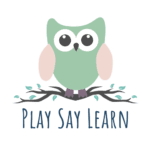11 Prelinguistic Skills Toddlers Must Master Before Talking:
What Every Parent Needs to Know About Early Speech Development


In the first year of life, one of the most exciting and transformative milestones that a baby achieves is the ability to communicate. Through experience and interaction with the world, a baby learns to understand and use language and it is quite an amazing feat! As a speech therapist, I often get inquiries when parents notice that those first words haven’t been spoken yet at 15 or 16 months. It can be frustrating when you’re holding up that cookie, asking your child to repeat the word, and he just can’t do it.
Teaching your child to talk isn’t as simple as getting him to look at you and repeat the word you say for the thing he wants. Before we can expect a child to say his first words, he must have mastered a set of prelinguistic skills that lay the groundwork for successful communication and pave the way for spoken language. In this blog post, we will explore 11 skills that your child must master before learning to talk. By understanding and nurturing these skills, you can actively support your child’s language development and promote effective communication.
What are prelinguistic skills?
Prelinguistic skills are the foundational abilities that toddlers develop before they begin to use spoken language. These skills encompass a range of essential capabilities such as joint attention, turn-taking, imitation, and gesturing. They involve a toddler’s responsiveness to the environment and people around her, her ability to engage in social interactions, and her aptitude for communication through non-verbal means like gestures, vocalizations, and purposeful actions. Prelinguistic skills serve as the stepping stones that lay the groundwork for language acquisition, setting the stage for later speech and language development. Let’s dive into the 11 skills!
*Information provided below has been adapted from the work of Laura Mize “11 Skills Toddlers Master Before Words Emerge” in Let’s Talk About Talking.
11 Prelinguistic Skills Toddlers Need to Master Before Talking
1. Responds to the Environment:
The ability to respond to the environment is a fundamental prelinguistic skill. Babies gradually learn to react to various sensory stimuli, such as sounds, sights, and touch. By responding to their surroundings, children develop an awareness of the world and create opportunities for language learning. For instance, when a child turns her head towards a ringing phone or reacts to the sound of a car passing by, she demonstrates her responsiveness to the environment. You can help your child learn to use her senses by exploring things in her environment and exposing her to new experiences. Offer toys designed for babies that are visually appealing and that she can hold and explore with both her hands and mouth.
2. Responds to People:
Interacting with others is a crucial aspect of language development. Babies gradually learn to respond to people around them, building connections and engaging in social exchanges. By acknowledging and reacting to caregivers, siblings, or peers, children develop social awareness and lay the groundwork for future communication skills. For example, a toddler who smiles or reaches out when their parent approaches demonstrates their responsiveness to people. These are good signs that your child enjoys being around other people. I encourage parents to make sure their child is interacting with people as much as possible. Don’t leave him alone for long periods of time. Make eye contact with your child and use engaging, warm facial expressions with him so that he wants to interact with you.
3. Turn-Taking:
Turn-taking is a key skill that facilitates reciprocal interactions and social communication. Babies and toddlers gradually learn to take turns during play, conversations, and activities. They learn to participate in extended back and forth exchanges with others. You might notice your baby first taking turns with you when he first starts to make “cooing” sounds around 2 months of age. Let him coo and then take a turn by imitating him and “cooing” back. Pause and wait for him to take another turn and keep this interaction going for as long as you can. This will likely be your first experience “talking” back and forth with him, and it is adorable and exciting! Through turn-taking, children learn the importance of listening, waiting, and responding appropriately. For instance, when a child hands a toy to their caregiver and waits for it to be returned before continuing the play, they demonstrate their understanding of turn-taking.
4. Develops a Longer Attention Span:
As children grow, their attention span gradually increases. Developing a longer attention span is vital for language acquisition, as it allows toddlers to engage with activities, stories, and conversations for extended periods. With an extended attention span, children can absorb new vocabulary, follow narratives, and actively participate in linguistic interactions. For example, a toddler who can sit and listen to a storybook for several minutes showcases their developing attention span. Eventually you will see that your toddler can sit for 5 minutes alone with an activity and even longer when an adult is engaging with her. The best advice I can give is to LIMIT SCREEN TIME FOR BABIES AND TODDLERS. It sabotages their attention span, to put it mildly and research shows that screen time can cause changes in the brains of children that have a negative impact on learning and attention. Please, no ipads or phones for babies and toddlers. I cannot stress this enough!
One other trick I like to use is the “one more” strategy. When I am just about to lose a child’s attention during an activity, I say “One more” and assist him as needed to complete one more turn with something before putting it away and moving on. This helps a child extend his attention just a little bit with each activity and little by little, we can improve attention span.
5. Joint Attention:
Joint attention involves the ability to focus on the same object or event as another person. A child learns to shift his attention between an object and you while you’re sharing the same focus. It encompasses shared experiences, coordinating eye gaze, and demonstrating interest. Joint attention provides a foundation for social communication and language development. For instance, when a child and caregiver both look at a picture book together, pointing and discussing the illustrations, they engage in joint attention and lay the groundwork for meaningful communication. You can work on this with your child in several ways. Place yourself in your child’s line of vision. Play a game where he has to look for you. Point and gesture often while holding your child and direct his attention to different objects. Use lots of expression in your face and voice to keep him interested and entice him to look at what you are pointing to. You can learn more about how to work on joint attention with your child in this post here.
6. Plays with a Variety of Toys:
Playing with a variety of toys exposes toddlers to different shapes, colors, textures, and functions. This diversity stimulates their cognitive, motor, and language skills. By exploring various toys, children expand their vocabulary, learn to describe attributes, and engage in imaginative play. During their first year, babies learn to play with different toys and use familiar objects in everyday routines. Play is the work of a child! They learn almost everything through play. Play skills must develop to a certain level before language skills are possible. Language and play are interconnected. I encourage parents to incorporate play into their child’s routine daily by playing with him and showing him what to do with a toy. Use a variety of toys to teach cognitive concepts such as object permanence, cause and effect and simple problem solving. For more on using toys to teach these concepts, read the post here.
7. Understands Words and Follows Directions:
Comprehension of words and following directions is a crucial milestone in prelinguistic development. Toddlers gradually develop the ability to understand and interpret verbal cues from their caregivers. By comprehending words and following directions, children build receptive language skills and establish a foundation for expressive language. For instance, a toddler who can identify and find a specific toy when asked by her caregiver demonstrates her comprehension, or receptive language skills. A child must understand words before she can use those words to communicate. You can help your child by keeping your language simple and narrating everyday activities. Have your child take part in everyday activities by giving her tasks to complete such as retrieving a clean diaper, throwing out a diaper, finding keys, or helping to clean up toys.
8. Vocalizes Purposefully:
Vocalizing purposefully refers to a toddler’s intentional use of vocal sounds to communicate or express needs and desires. As children gain control over their vocalizations, they begin to produce purposeful babbling, imitate sounds, and experiment with different speech-like noises. During her first year, your baby will become noisy and learn that she can get your attention by using her voice. For example, a child who makes specific sounds to indicate they want more food or to get attention demonstrates purposeful vocalization. You can help by imitating any sounds your baby makes. Model lots of different play sounds, as your baby will learn to use these sounds first as a precursor to saying true words. For example, imitate vehicle noises, animal sounds and other sounds in the environment such as running water, pouring liquid into a cup, or making an “ahhh” sound after sipping a drink.
9. Imitates Actions, Gestures, and Sounds:
Imitation plays a crucial role in prelinguistic development. Toddlers imitate the actions, gestures, and sounds they observe in their environment. By imitating others, children develop the ability to replicate facial expressions, gestures, and eventually, speech sounds. For instance, when a child claps her hands after seeing someone else do it or attempts to imitate animal sounds, she is showing us that she is mastering imitative skills. Imitation typically occurs in a sequence. Before a child can imitate true words, she will learn to imitate our actions, gestures, facial expressions and eventually sounds and vocalizations. We will first hear play sounds such as vehicle noises, animal sounds, and attempts to imitate environmental sounds. You can help by modeling these sounds for your child as you play and in your everyday routines. Pause and show her with your facial expression that you are waiting for her to take a turn making the sound and chances are, she will follow your lead.
10. Uses Gestures to Communicate:
Gestures serve as powerful tools for preverbal communication. Toddlers use gestures such as pointing, reaching, and waving to express their needs, desires, and intentions. Using gestures allows children to communicate effectively before they acquire spoken language skills. In typical development, gestures emerge just before toddlers begin to talk. For example, a child who points to a cup to indicate they want a drink or waves goodbye demonstrates their ability to use gestures to communicate. You can help your child understand and use gestures by using lots of gestures as you talk. Start by having a child first imitate larger, whole body movements such as jumping. Then teach other gestures such as reaching out with an arm, waving, high five and shaking head “no”. You can then teach more refined movements such as pointing with an index finger. To learn more about the milestone of “16 gestures by 16 months” read this post here.
11. Initiates Interactions:
The ability to initiate interactions is a significant milestone in prelinguistic development. Toddlers gradually learn to take the lead in social exchanges, seeking engagement and initiating communication. They learn to work to get your attention and get their needs and desires met. By initiating interactions, children demonstrate their social awareness and the desire to connect with others. For instance, a child who approaches a peer to share a toy or initiates a game with a caregiver shows us her ability to initiate interactions. One way you can help your toddler learn to initiate is by purposefully setting up situations where a child needs to request something that they want. We call this “sabotage” or “communicative temptation”. For example, place a desired item in a clear container and close it tightly or put it out of the child’s reach and wait, enticing your child to let you know he needs help. Blow bubbles with your child then close the jar tightly and hand it to him. Wait expectantly for him to hand it back to you to ask for help opening. You can also activate a wind-up toy, let it deactivate and hand it to your child. We want to see him hand it back to you or initiate his request for help in some way to activate the toy again.
Mastering these 11 crucial prelinguistic skills lays a strong foundation for a toddler’s language development. Responding to the environment and people, turn-taking, developing a longer attention span, joint attention, playing with a variety of toys, understanding words and following directions, purposeful vocalization, imitation of actions and sounds, using gestures to communicate, and initiating interactions are the building blocks that pave the way for successful communication and language acquisition. By recognizing and nurturing these skills, parents and caregivers can actively support their child’s prelinguistic development, setting them on a path toward effective communication and success with learning to talk.
Milestone Checklist
Wondering what speech-language milestones to expect in your baby's first year? Click below to grab your free copy of the checklist!
DOWNLOAD HERE
